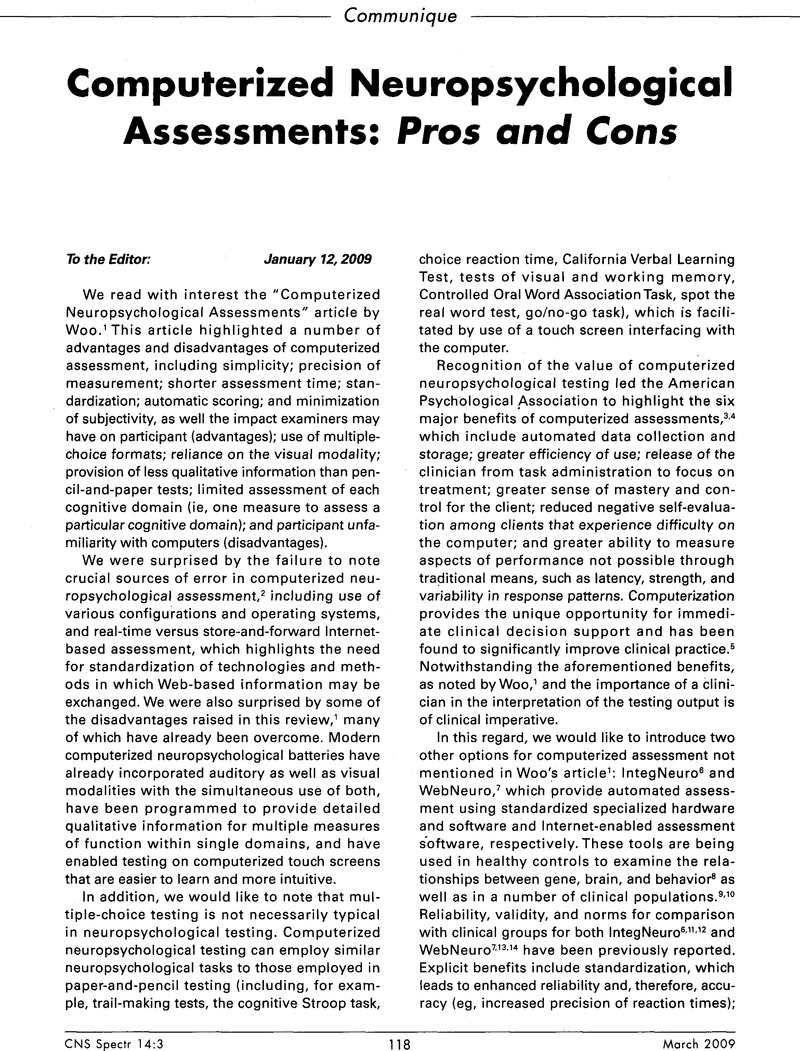Crossref Citations
This article has been cited by the following publications. This list is generated based on data provided by Crossref.
NICHOLLS, MICHAEL E.R.
CHAPMAN, HEIDI L.
LOETSCHER, TOBIAS
and
GRIMSHAW, GINA M.
2010.
The relationship between hand preference, hand performance, and general cognitive ability.
Journal of the International Neuropsychological Society,
Vol. 16,
Issue. 4,
p.
585.
Quinn, Candice R
Harris, Anthony
Felmingham, Kim
Boyce, Philip
and
Kemp, Andrew
2012.
The impact of depression heterogeneity on cognitive control in major depressive disorder.
Australian & New Zealand Journal of Psychiatry,
Vol. 46,
Issue. 11,
p.
1079.
Quinn, Candice
Harris, Anthony
and
Kemp, Andrew
2012.
The Interdependence of Subtype and Severity: Contributions of Clinical and Neuropsychological Features to Melancholia and Non-melancholia in an Outpatient Sample.
Journal of the International Neuropsychological Society,
Vol. 18,
Issue. 2,
p.
361.
Martínez-Pernía, David
Núñez-Huasaf, Javier
del Blanco, Ángel
Ruiz-Tagle, Amparo
Velásquez, Juan
Gomez, Mariela
Robert Blesius, Carl
Ibañez, Agustin
Fernández-Manjón, Baltasar
and
Slachevsky, Andrea
2017.
Using game authoring platforms to develop screen-based simulated functional assessments in persons with executive dysfunction following traumatic brain injury.
Journal of Biomedical Informatics,
Vol. 74,
Issue. ,
p.
71.
Williams, Leanne M.
Coman, John T.
Stetz, Patrick C.
Walker, Nicole C.
Kozel, F. Andrew
George, Mark S.
Yoon, Jong
Hack, Laura M.
Madore, Michelle R.
Lim, Kelvin O.
Philip, Noah S.
and
Holtzheimer, Paul E.
2021.
Identifying response and predictive biomarkers for Transcranial magnetic stimulation outcomes: protocol and rationale for a mechanistic study of functional neuroimaging and behavioral biomarkers in veterans with Pharmacoresistant depression.
BMC Psychiatry,
Vol. 21,
Issue. 1,
Castelnovo, Veronica
Canu, Elisa
Riva, Nilo
Poletti, Barbara
Cividini, Camilla
Fontana, Andrea
Solca, Federica
Silani, Vincenzo
Filippi, Massimo
and
Agosta, Federica
2021.
Progression of cognitive and behavioral disturbances in motor neuron diseases assessed using standard and computer-based batteries.
Amyotrophic Lateral Sclerosis and Frontotemporal Degeneration,
Vol. 22,
Issue. 3-4,
p.
223.
Latendorf, Antje
Runde, Lina Marie
Salminen, Tiina
and
Steinert, Anika
2021.
Digitization of neuropsychological diagnostics: a pilot study to compare three paper-based and digitized cognitive assessments.
Aging Clinical and Experimental Research,
Vol. 33,
Issue. 6,
p.
1585.
Diaz, Daniel
Cadena, Steban
Gil, Juan
Chaves, Deisy
and
Trujillo, Maria
2021.
Gerontechnology III.
p.
81.
Veraksa, Nikolay E.
Aslanova, Margarita S.
Tarasova, Kristina S.
and
Klimenko, Viktor A.
2023.
Technique for Diagnosing Cognitive Flexibility in Preschoolers: Comparison of Blank and Digital Forms.
RUDN Journal of Psychology and Pedagogics,
Vol. 20,
Issue. 1,
p.
105.





